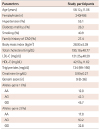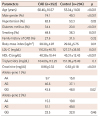1. Okrainec K, Banerjee DK, Eisenberg MJ. Coronary artery disease in the developing world. Am Heart J. 2004; 148:7–15.
2. Ahn SG, Yoon J, Kim J, et al. genotype- and phenotype-directed personalization of antiplatelet treatment in patients with non-ST elevation acute coronary syndromes undergoing coronary stenting. Korean Circ J. 2013; 43:541–549.
3. Shin DJ, Lee SH, Park S, Jang Y. Association between serine/threonine kinase 39 gene polymorphism, hypertension, and other cardiovascular risk factors in Koreans. Korean Circ J. 2013; 43:13–22.
4. Yoo SY, Kim J, Cheong S, et al. Rho-associated kinase 2 polymorphism in patients with vasospastic angina. Korean Circ J. 2012; 42:406–413.
5. Chan L, Boerwinkle E. Gene-environment interactions and gene therapy in atherosclerosis. Cardiol Rev. 1994; 2:130–137.
6. Roberts R, Stewart AF. Genes and coronary artery disease: where are we? J Am Coll Cardiol. 2012; 60:1715–1721.
7. McPherson R, Pertsemlidis A, Kavaslar N, et al. A common allele on chromosome 9 associated with coronary heart disease. Science. 2007; 316:1488–1491.
8. Helgadottir A, Thorleifsson G, Manolescu A, et al. A common variant on chromosome 9p21 affects the risk of myocardial infarction. Science. 2007; 316:1491–1493.
9. Wellcome Trust Case Control Consortium. Genome-wide association study of 14,000 cases of seven common diseases and 3,000 shared controls. Nature. 2007; 447:661–678.
10. Ding H, Xu Y, Wang X, et al. 9p21 is a shared susceptibility locus strongly for coronary artery disease and weakly for ischemic stroke in Chinese Han population. Circ Cardiovasc Genet. 2009; 2:338–346.
11. Hinohara K, Nakajima T, Takahashi M, et al. Replication of the association between a chromosome 9p21 polymorphism and coronary artery disease in Japanese and Korean populations. J Hum Genet. 2008; 53:357–359.
12. Saleheen D, Alexander M, Rasheed A, et al. Association of the 9p21.3 locus with risk of first-ever myocardial infarction in Pakistanis: case-control study in South Asia and updated meta-analysis of Europeans. Arterioscler Thromb Vasc Biol. 2010; 30:1467–1473.
13. Kumar J, Yumnam S, Basu T, et al. Association of polymorphisms in 9p21 region with CAD in North Indian population: replication of SNPs identified through GWAS. Clin Genet. 2011; 79:588–593.
14. Palomaki GE, Melillo S, Bradley LA. Association between 9p21 genomic markers and heart disease: a meta-analysis. JAMA. 2010; 303:648–656.
15. Helgadottir A, Thorleifsson G, Magnusson KP, et al. The same sequence variant on 9p21 associates with myocardial infarction, abdominal aortic aneurysm and intracranial aneurysm. Nat Genet. 2008; 40:217–224.
16. Emanuele E, Lista S, Ghidoni R, et al. Chromosome 9p21.3 genotype is associated with vascular dementia and Alzheimer's disease. Neurobiol Aging. 2011; 32:1231–1235.
17. Kral BG, Mathias RA, Suktitipat B, et al. A common variant in the CDKN2B gene on chromosome 9p21 protects against coronary artery disease in Americans of African ancestry. J Hum Genet. 2011; 56:224–229.
18. Munir MS, Wang Z, Alahdab F, et al. The association of 9p21-3 locus with coronary atherosclerosis: a systematic review and meta-analysis. BMC Med Genet. 2014; 15:66.
19. Gensini GG. A more meaningful scoring system for determining the severity of coronary heart disease. Am J Cardiol. 1983; 51:606.
20. Yusuf S, Hawken S, Ounpuu S, et al. Effect of potentially modifiable risk factors associated with myocardial infarction in 52 countries (the INTERHEART study): case-control study. Lancet. 2004; 364:937–952.
21. Di Chiara A, Vanuzzo D. Does surveillance impact on cardiovascular prevention? Eur Heart J. 2009; 30:1027–1029.
22. CARDIoGRAMplusC4D Consortium. Deloukas P, Kanoni S, et al. Large-scale association analysis identifies new risk loci for coronary artery disease. Nat Genet. 2013; 45:25–33.
23. Franceschini N, Carty C, Bůzková P, et al. Association of genetic variants and incident coronary heart disease in multiethnic cohorts: the PAGE study. Circ Cardiovasc Genet. 2011; 4:661–672.
24. Dandona S, Stewart AF, Chen L, et al. Gene dosage of the common variant 9p21 predicts severity of coronary artery disease. J Am Coll Cardiol. 2010; 56:479–486.
25. Congrains A, Kamide K, Oguro R, et al. Genetic variants at the 9p21 locus contribute to atherosclerosis through modulation of ANRIL and CDKN2A/B. Atherosclerosis. 2012; 220:449–455.
26. Yap KL, Li S, Muñoz-Cabello AM, et al. Molecular interplay of the noncoding RNA ANRIL and methylated histone H3 lysine 27 by polycomb CBX7 in transcriptional silencing of INK4a. Mol Cell. 2010; 38:662–674.
27. Vijayachandra K, Higgins W, Lee J, Glick A. Induction of p16ink4a and p19ARF by TGFbeta1 contributes to growth arrest and senescence response in mouse keratinocytes. Mol Carcinog. 2009; 48:181–186.
28. Chen HH, Almontashiri NA, Antoine D, Stewart AF. Functional genomics of the 9p21.3 locus for atherosclerosis: clarity or confusion? Curr Cardiol Rep. 2014; 16:502.
29. Çakmak HA, Bayoğlu B, Durmaz E, et al. Evaluation of association between common genetic variants on chromosome 9p21 and coronary artery disease in Turkish population. Anatol J Cardiol. 2015; 15:196–203.
30. Onat A, Uğur M, Ciçek G, et al. The Turkish Adult Risk Factor survey 2009: similar cardiovascular mortality in rural and urban areas. Turk Kardiyol Dern Ars. 2010; 38:159–163.










 PDF
PDF ePub
ePub Citation
Citation Print
Print


 XML Download
XML Download